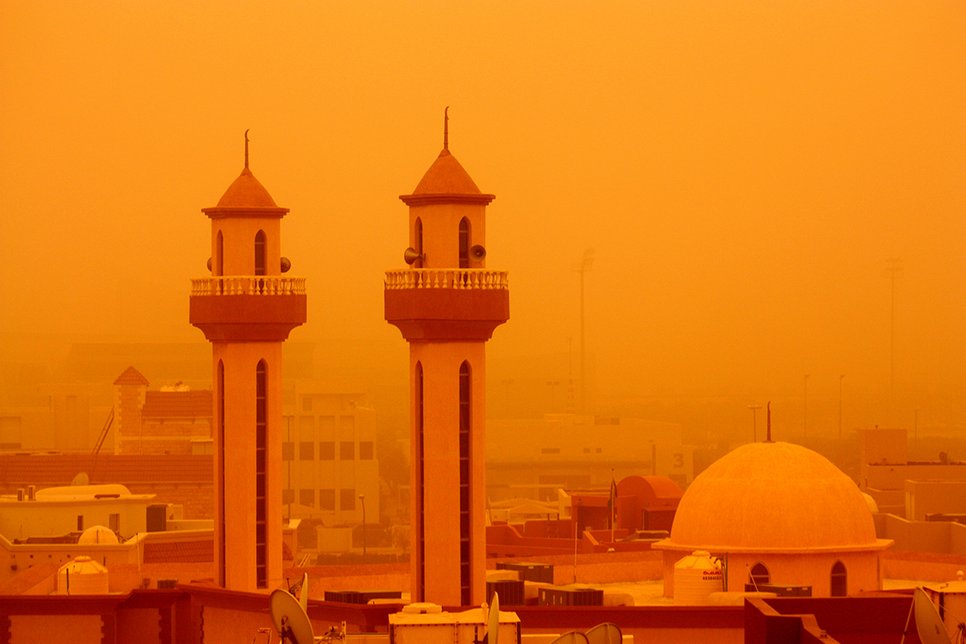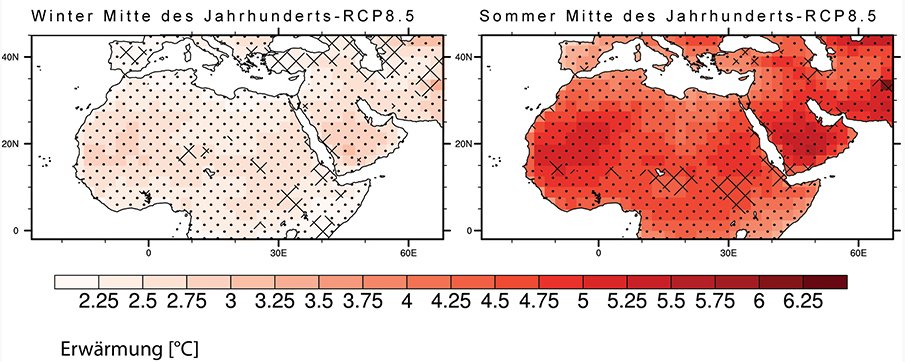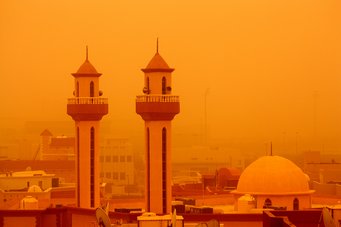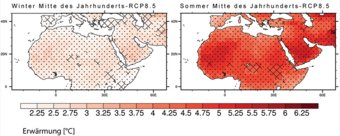Climate-exodus imminent in the Orient
Part of the Middle East and North Africa may become uninhabitable due to climate change
The number of climate refugees could increase dramatically in future. Researchers of the Max Planck Institute for Chemistry and the Cyprus Institute in Nicosia have calculated that the Middle East and North Africa could become so hot that human habitability is compromised n many parts. The goal of limiting global warming to less than two degrees Celsius, agreed at the recent UN climate summit in Paris, will not be sufficient to prevent this from happening. The average temperature during summer in the already very hot regions of the Orient will increase at least twice that of global warming. This means that temperatures south of the Mediterranean will reach around 46 degrees Celsius (approximately 114 degrees Fahrenheit) on particularly hot days by mid-century. Such extremely hot days will occur five times more often than at the turn of the millennium. In combination with increasing air pollution by windblown desert dust, the environmental conditions will become intolerable and might force people to migrate.
More than 500 million people live in the Middle East and North Africa - a region which is very hot in summer and where climate change is already evident. The number of extremely hot days has doubled since 1970. “In future, the climate in large parts of the Orient could change such that the very existence of the population is in jeopardy,” says Jos Lelieveld, Director at the Max Planck Institute for Chemistry and Professor at the Cyprus Institute.

Desert dust storms such as here in Kuwait could occur more often in the Middle East and North Africa as a result of climate change. In addition, temperatures on very hot days could rise to 50 degrees Celsius on average in the region (approximately 122 degrees Fahrenheit) by the end of the century.
Lelieveld and his colleagues have investigated how temperatures will develop in the Middle East and North Africa over the course of the 21st century. The result is frightening: Even if the Earth’s temperature were to increase on average only by two degrees Celsius compared to pre-industrial times, the temperature in summer in these regions will increase more than twofold. By mid century, during the warmest periods, thermometers will not fall below 30 degrees at night, and during daytime they could rise to 46 degrees Celsius (approximately 114 degrees Fahrenheit). By the end of the century, midday temperatures on hot days could even reach 50 degrees Celsius (approximately 122 degrees Fahrenheit). Another finding: Heat waves could occur ten times more often.
At mid century, 80 instead of 16 extremely hot days
In addition, the duration of heat waves in regions of North Africa and the Middle East will prolong dramatically. Between 1986 and 2005, it was very hot for an average period of about 16 days, by mid century it will be unusually hot for 80 days per year, and at the end of the century up to 118 days could be unusually hot, even if greenhouse gas emissions decline again after 2040. “If mankind continues to release carbon dioxide as it does now, people living in the Middle East and North Africa will have to expect about 200 unusually hot days for,” says Panos Hadjinicolaou, Professor at the Cyprus Institute and climate expert.
Atmospheric researcher Jos Lelieveld is convinced that climate change will have a large impact on the environment and the health of people in these regions. “Climate change will significantly worsen the living conditions in the Middle East and in North Africa. Prolonged heat waves and desert dust storms will render many regions uninhabitable, which will surely contribute to the pressure to migrate,” says Jos Lelieveld.

The research team recently also published findings on the increase of fine particulate air pollution in the Middle East. It was found that desert dust in the atmosphere over Saudi Arabia, Iraq and in Syria has increased by up to 70 percent since the beginning of the century. This is mainly attributable to an increase of sand storms as a result of increasing droughts. It is expected that climate change will contribute to further increases, which will worsen environmental conditions in the area.
In the now published study, Lelieveld and his colleagues first compared climate data from 1986 to 2005 with predictions from 26 climate models over the same time period. It was shown that the measurement data and model predictions corresponded excellently, hence the scientists used these models to project climate conditions for the period 2046 to 2065 and the period 2081 to 2100.
Largest temperature increase in already hot summers
The researchers based their calculations on two future scenarios: The first scenario, called RCP4.5, assumes that the global emissions of greenhouse gases will start decreasing by 2040 and that the Earth will be subjected to warming by 4.5 Watt per square meter by the end of the century. The RCP4.5 scenario roughly corresponds to the target set at the most recent UN climate summit, which means that global warming should be limited to less than two degrees Celsius.
The second scenario (RCP8.5) is based on the assumption that greenhouse gases will continue to increase without further limitations. Therefore, it is called the “Business-as-usual scenario.” According to this scenario, the mean surface temperature of the Earth will increase by more than four degrees Celsius compared to pre-industrial times.
In both scenarios, the strongest rise in temperature in the Middle East and North Africa is expected during summer, when it is already very hot, and not during winter, which is more common in other parts of the globe. This is primarily attributed to a desert warming amplification in regions such as the Sahara. Deserts which do not buffer heat well. Thus, the hot and dry surface cannot cool by the evaporation of ground water. Since the surface energy balance is controlled by the transfer of thermal radiation, the greenhouse effect by gases such as carbon dioxide and water vapor will increase disproportionately.
Regardless of which climate change scenario will become reality: Lelieveld and Hadjinicolaou agree that climate change will result in a significant deterioration of living conditions for people living in North Africa and the Middle East, and consequently, sooner or later, many people might have to leave the region.

